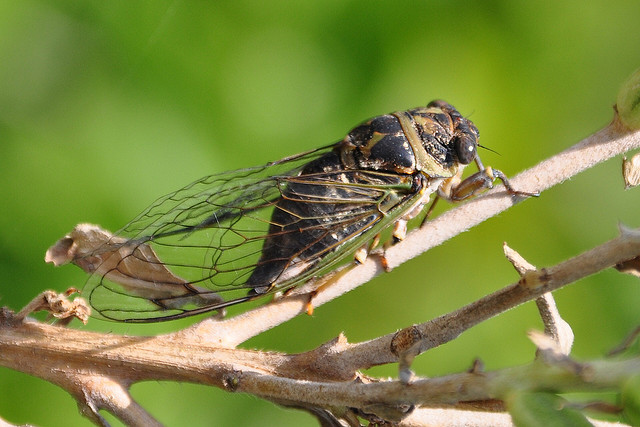
Nutrition
Although Tibicen canicularis does not have a specific diet, they do feed on a variety of trees. Their choice of nutrition can range from feeding on deciduous trees or living in mixed forests (BugGuide, 2013).
Nymphs can burrow their way through the ground to find roots to feed on and can feed for years (Cicada, 2013). As the nymphs feed and develop, they can remain safe in their underground chambers. While they can still fall prey to a few fungi and become exposed to the surface by pigs and other rooting animals, they will remain safe as they develop (Cicada, 2013).
It was originally thought that mature cicadas do not feed during
their adult lives; however, after a few studies were conducted, it
was found that adult cicadas did draw sap from a few of the trees it
lived on
(Snodgrass, 1921). Mature cicadas are also able to receive
nourishment from the trees it lives on as well as other softened,
woody vegetation.
 The mature cicada utilizes its long, beak-like
mouth to draw the sap from the plant into its mouth.
(Snodgrass, 1921). The adult
cicada does little to no damage during its visit aboveground. The
only sufficient damage the cicada does to the trees and vegetation
it lives on is done by the female when she uses her ovipositor to
lay her eggs. After the female has finished laying her eggs, the
twigs will usually wilt and die (Hall, 1902).
The mature cicada utilizes its long, beak-like
mouth to draw the sap from the plant into its mouth.
(Snodgrass, 1921). The adult
cicada does little to no damage during its visit aboveground. The
only sufficient damage the cicada does to the trees and vegetation
it lives on is done by the female when she uses her ovipositor to
lay her eggs. After the female has finished laying her eggs, the
twigs will usually wilt and die (Hall, 1902).
Click here to learn how the
cicada reproduces!
Or
Go back to Home